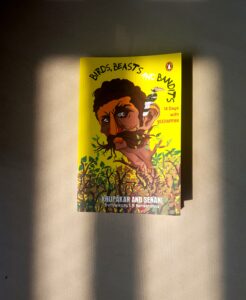Book Review: Birds Beasts and Bandits, 14 days with Veerappan
 “It is impossible to grasp another human’s inner world. But even in the darkness of the densest forest, there can always be the light of a firefly.”
“It is impossible to grasp another human’s inner world. But even in the darkness of the densest forest, there can always be the light of a firefly.”
– Krupakar, Birds, Beasts, and Bandits: 14 Days with Veerappan
Dense forests are a fascinating ecosystem of contrasts – full of raging wild beasts, slithering snakes, shrieking birds, shadowy trees and wheezing insects all dissolving into the viscous stygian darkness of ether at night while the dawn reveals the shimmering sunshine filtering through the canopy, the rich flora and fauna, the soothing water falls, singing birds, grazing animals and prowling beasts, the undulating mountains and plains and the dense grasslands, all dissolving into and rising from the earth. This eternal dance of day and night, of darkness and light, of dissolution and regeneration continues, disregarding the human gaze.
Is the forest then good or bad? The forest just is. It is the human gaze that can and needs to change. Krupakar and Senani’s Birds, Beasts and Bandits 14 Days with Veerappan is a beautiful reflection on our compulsive need to bracket things with adjectives and lay down rigid rules of taxonomy that create either adherents or outcasts. It patiently examines and admires the complexity of the forest, its birds and beasts and reflects the mercurial psyche of the one of the most feared bandits of recent times – Veerappan, the smuggler, poacher and murderer. But what makes this account important is the candid, non-judgemental depiction of a side of Veerappan that media reports, popular films and even books seem to have ignored. Like avid researchers, Krupakar and Senani observe the bandit and his gang and how they respond to the world around them without judgement.
Krupakar and Senani, bird enthusiasts and wildlife researchers living on the outskirts of Bandipur National Park, get kidnapped one night by none other than Veerappan. Veerappan was mistakenly informed that Krupakar and Senani were high ranking government officials and any attempt by the duo to explain otherwise fell on deaf ears. Thus begins the duo’s 14-day stint in the forests of Bandipur under the net of the watchful eyes of Veerappan and his men. First written for a Kannada daily, this event marks the beginning of a serialised account of their experiences with Veerappan.
Unfazed by the sudden twist in their circumstances, the duo continue to cooperate with the gang of bandits, all the while trying to explain their inconsequentiality. Veerappan abducts a few more hostages, a scientist from West Bengal, a cleaner, a driver and a pump operator from the national park before disappearing into the forests again. Krupakar and Senani take in the new hostages under their wings, too. Their sincerity, disarming humour and their ability to show grace even under pressure is admirable. They use soft power against the gun power of the gang and over the course of a few days, win over the gang members with their simplicity, lack of guile and nonpartisan attitude. The alternating first person accounts of Krupakar and Senani offer different viewpoints to the events that unfold over the fortnight.
The birds and beasts of the title are many and several interesting anecdotes are scattered throughout the book. What’s interesting is that many of these anecdotes come from the bandit captors and not just the captive researchers. Of particular note is Veerappan’s dramatic reconstruction of the killing of a sambar deer at the paws of a tiger. His uncanny ability to read pug marks and other signs in the forest to deduce exactly what might have happened and when arouses admiration. Veerappan’s knowledge of the plant life, especially indigenous plants put even Dr. Maithi, a researcher of crops, to shame.
The dacoit could identify many birds and insects, could imitate their calls to perfection and could predict with remarkable accuracy the presence of and movement of all sorts of animals in the forest, their habits, calls and even behaviour patterns. And if one thinks that this familiarity with the forest life would be the natural product of him having to live in forests to escape arrest; after all if he had to survive in the forest, then he would have to learn to understand it, then one is highly mistaken. He could imitate the sounds of most animals and bird with such alarming perfection that animals responded to his calls, too! This sort of intimate knowledge of the forest and its inhabitants can elude even seasoned ornithologists, botanists and researchers.
Even some members of his gang, many of whom were initiates, could effortlessly read the language of the forest and use it to their advantage. For example, in one incident, the gang was in the mood to have langur meat. Krupakar and Senani were confident that langurs couldn’t be found in the grassland that they were then in and were betting on the hunters to return empty-handed. To their amazement and surprise, the gang returned with a dead langur. Upon investigation, they found that all he had to do was walk some distance into the grasslands and make impeccably fluent monkey calls and out of nowhere, a large troop of langurs answered the call and appeared! One shot is all it took to get a large langur! The reader can fully understand when the authors feel shocked and almost faint. And Veerappan’s explanation to this shows his eerie knowledge of animal life and the ease with which he could exploit that knowledge – “Sheni, did you see? You call out like this and the langurs will come where you want them to. You choose one and then… dhamaar!”
Apart from his awe-inspiring knowledge of the forest, Veerappan also had other redeeming qualities. He and his gang could become one with the forest at will and his and his gang’s curiosity to learn is enough to melt even the most hardened hearts. They leave no opportunity to listen to the authors and absorb their mini lectures and lessons on a wide range of topics – forests, birds, animals, civilisation and the world outside the jungle, destiny, law, order and justice, God and religion, food, music, traditional dances and even some lessons on literacy and language! And no, Veerappan wasn’t just a listener. He asked frequent questions that revealed his razor-sharp intellect! Like the authors, the reader has to admit and wonder, “With so much going for him, why had he strayed and become cruel? Wouldn’t he have been equally well known had he taken the right path?”
Through these many conversations, discussions and even debates that the gang has with the captive researchers, the reader can gleam the complexity of Veerappan’s sharp but scarred and disturbed mind. He was willing to listen (and not just hear) but quick to act. He was highly knowledgeable in many ways and invariably listened to news twice a day and yet had no understanding of the world outside the forests he roamed. He was affectionate, unassuming and like a child, eager to please but suspicious and obdurate, nonetheless. He grabbed, kidnapped and killed without batting an eyelid but returned all the objects he had gathered from Krupakar and Senani’s home while releasing them. He killed informers and ruined villages of people he suspected to have sided with the police but was deeply hurt and agitated by the possibility that Krupakar and Senani might have to sell their home and leave the forest. He was deeply religious and prayed twice everyday but refused to respect animals such as elephants and monkeys. In fact, his views on many topics come off as very progressive and modern. He was a connoisseur of and, by his own account, one of the last custodians of a form of traditional dance! He admired Yudhisthira from Mahabharata and Rama from Ramayan but Prabhakaran of LTTE, too!
His childhood losses and the agony of losing his family and his village in a raid seemed to have scarred him forever and warped his sense of justice and personal accountability. He was wronged in his childhood and in recent times, according to his own questionable and yet plausible accounts, by the government officials, other gangs of poachers, police, army and even the media! And yet he couldn’t see the ‘wrong’ in his own acts. His inability to resolve this dichotomy is indeed pitiable. (The cover design beautifully captures the many and ever-shifting sides of Veerappan.)
It is in showcasing this other gentle and confounding side of Veerappan that the importance of this account lies. All popular narratives on Veerappan portray him as a ruthless, conniving and cruel brigand, and perhaps rightly so. However, the reader cannot ignore the good in this evil. The difficulties of understanding how the human mind works are indeed many! Take for instance, one of the captives’ refusal to be released by Veerappan, simply because it was dark and cold already! The book is not just an account of the days the authors spent with Veerappan in the forests of Bandipur but also a reflection on the workings of the human mind and an inquiry into the nature and cause of evil.
The authors sympathise with Veerappan but do not condone his actions. In fact, their level-headedness in the face of this crisis, their willingness to observe and understand rather than to judge, their efforts to dissuade and convert a hardcore criminal and their irresistible sense of humour to make light of what cannot be helped is admirable. Though the accounts have been written in first person and are thus subject to all the shortcomings of first-person narratives, the accounts do evoke some sympathy and the reader is left wishing that Veerappan’s strengths had been more productively put to use.
The only thing that could have improved the readability of these accounts and the book is if it had been edited more consistently. The narrator (Krupakar or Senani) of the account has been clearly marked and highlighted in the beginning two chapters. However, in absence of this marking in all the subsequent chapters, it is difficult for the reader to work out who the narrator is and therefore infer the references and substitutions implied by the many pronouns in several passages, occasionally resulting in ambiguity and confusion. This could have been the result of translation from Kannada as well, but the editor(s) could have easily ironed this out.
The authors have worked their way out of an unprecedented situation and presented a candid account that throws light on the many wonders of the forest, the elusiveness of the human mind and the nature of good and evil and of good in evil, too. It is also a convincing cry to abandon the all-judging gaze and like the forest, learn to let the beings just be! In not judging but rather in ‘seeing’ and understanding lies redemption! I can’t agree more.
Book Details:
Title: Birds Beasts and Bandits 14 Days with Veerappan
Authors: Krupakar and Senani, Translated in English by S.R. Ramakrishna
Publisher: Penguin Random House India
First Published: Kannada edition in 1998, English translation first published in 2011
